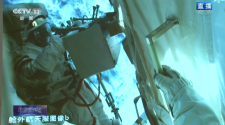You are using an out of date browser. It may not display this or other websites correctly.
You should upgrade or use an alternative browser.
You should upgrade or use an alternative browser.
China's Space Program News Thread
- Thread starter crazyinsane105
- Start date
- Status
- Not open for further replies.
escobar
Brigadier
The group 2 has the same payload (radar from 14th Research Institute of CETC) as the group 1.The article was published in 2020, the satellites (two in a pair) were launched in April 2019. We know that China has launched many different constellations made up of different satellites such as GaoFen which are of both SAR and optic.
The recent pair could be different from the first. The claim from nasaspaceflight.com could be wrong too, but I think it is just an open question for the moment.
First kilometer milestone reached!


National Nature Science Foundation of China recently releases the R&D project it wants to initiate during the 14th FYP (five year plan). Among which, a project called "Space assembly dynamics and control of super large aerospace structures" raises an ambitious target for the development of "kilometer-class super large spacecraft".
According to the project guide, the ultra-large spacecraft with the size of the kilometer level is a major strategic aerospace equipment for the future use of space resources. The structural weight and size of the super large spacecraft are huge, which cannot be constructed by a single rocket launch. It needs to be constructed via modular design, multiple launches and space assembly.
Four development targets are thereof raised by the project guide:
1. Lightweight and controllable design of super large aerospace structures.
2. The dynamic evolution of the space assembly process of super large aerospace structures.
3. Orbit-attitude-structure integrated stability control during space assembly.
4. Ground simulation experiment of dynamics and control of space assembly process.
近日,国家自然科学基金委员会关于发布了“十四五”第一批重大项目指南,涵盖数学物理、化学、生命、地球、工程与材料、信息、管理、医学、交叉等九大领域,可以说每个项目都是重量级的。其中,“超大型航天结构空间组装动力学与控制”项目尤其让人感兴趣。
该项目指南提到,尺寸达千米量级的超大型航天器是未来空间资源利用、宇宙奥秘探索、长期在轨居住的重大战略性航天装备,需通过结构模块化设计、多次发射、空间组装的方式进行建造,并解决极其复杂的耦合动力学问题。
这对超大型航天器的动力学设计提出了两方面的要求:
一是结构的轻量化设计,以最大程度减少发射次数,降低建设成本;
二是结构的可控性设计,以有效抑制组装过程中组合体轨道与姿态漂移、控制结构变形与振动。
本项目的科学目标包括:
1、瞄准超大型航天结构的减重设计和空间组装需求,提出满足在轨动力学要求的组装结构轻量化设计新理论;
2、建立空间组装过程的“轨道-姿态-结构”耦合动力学新模型,揭示空间组装过程的耦合动力学演化新规律;
3、提出空间组装过程的“轨道-姿态-结构”一体化稳定控制新理论;
4、探索解决超大型航天结构动力学试验“天地一致性”问题的新方案。
研究内容则有四大方面,分别是:超大型航天结构的轻量化和可控性设计、超大型航天结构空间组装过程的动力学演化、空间组装过程轨道-姿态-结构一体化稳定控制、空间组装过程动力学与控制的地面模拟试验。按照要求,项目申请的直接费用预算不得超过1500万元。
Earth is too small. Time to conquer the solar system.
by78
General
Two video cameras developed by the Xi'an Institute of Optics and Mechanics for spacewalks. One is helmet mounted, and the other is waist mounted. The helmet cam records at 1080p using H.264 codec. The waist cam is VGA only, but it can be detached and used as a handheld. Both cameras were used in the second spacewalk from the Chinese Space Station.


- Status
- Not open for further replies.







